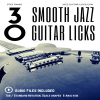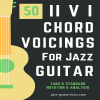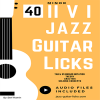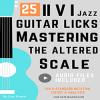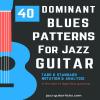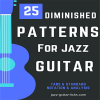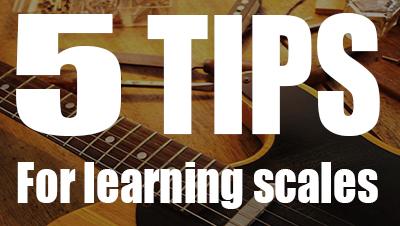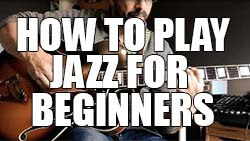
How To Play Jazz Guitar For Beginner
- By jazz-guitar-licks
- On 2017-11-03
- In Guest Posts
- 0 comments
 Guest post by Marc-Andre Seguin
Guest post by Marc-Andre Seguin
So, you've decided to try your hand at Jazz guitar. This article will assume a certain base level of proficiency in the general language of music apart from the specific vernacular that informs jazz music, guitarists specifically. Not because it's a theory article, but because if you hope to learn how to play this music (and any style, really) a little knowledge goes a long way. If you have no background in notated music, theory and harmony please pick up Barbara Wharram's Theory For Beginners. It will open the door.
The long view
The first thing I would suggest is to have a long term perspective on your progress. You probably won't absorb concepts nearly fast enough to satisfy your inner critic. If you listen to a lot of jazz (more on that later) you are starting to develop a set of aesthetic criteria for what you like and don't like. This is important. To paraphrase an internet meme I once saw, hating your own playing stems from being self aware and having good enough taste to realize that you sound terrible. Again, this is a good thing. It means you know what you like, and that's half the battle. (Or, maybe it's one third. I'm not sure of the exact percentages.)
So, be mindful of the fact that you are listening to players who have already put in many, many years of study and hard work and struggle to get where they are. If you are just starting out in jazz, you can't cram for the test. There is no test. It's just a thing you will do and at some point, you will have played a long time and you'll be able to say: Wow, how did I get here?
Listen To Jazz
Back to the listening thing. Get your hands on some jazz records/CDs/FLACs or whatever people listen to now. It doesn't have to be the entire history of jazz. Start with a good assortment of jazz guitar titles by players like Jim Hall, Wes Montgomery, Kenny Burrell, Joe Pass, and Grant Green. Also, please do listen to the classic records by non guitarists like Bill Evans, Miles Davis, John Coltrane, Sonny Rollins, and Charlie Parker, among countless others. The important thing is that you listen actively and engage with the music. Listening to a solid collection of  jazz records repeatedly over a period of time will do wonders for your ears and musical vocabulary. It also helps prevent the pitfall of getting mired in a terabyte of jazz records and feeling overwhelmed in the face of infinite choice
jazz records repeatedly over a period of time will do wonders for your ears and musical vocabulary. It also helps prevent the pitfall of getting mired in a terabyte of jazz records and feeling overwhelmed in the face of infinite choice
Try to listen to music without the distraction of other media or online activities. Sit in a comfy chair, use headphones and close your eyes. Try to imagine what the world was like when this music was recorded. Or if you like, read Miles Davis's autobiography while listening to Milestones. Read Chasing The Trane while absorbing Coltrane's Giant Steps. Immerse yourself in jazz. Just try to keep your listening time offline.
Depending on your musical background as a guitarist, you will relate to what you're hearing on recordings differently. If you come from blues, certain jazz guitar styles will already seem more familiar to you than the impressionistic piano style of Bill Evans. If you are a classical guitarist, the harmonies and fingerings required may be less alien, but you may not have the language to describe them in the same way a jazz player might. Long story short, start listening actively to jazz. A lot. You will be assimilating the music in ways that may not be apparent for a while, but rest assured, it's happening. Be patient and enjoy the ride. Listening to music is awesome.
Learn Some Chords, Scales and Arpeggios
Is it that simple? Not by a long shot. But you'd be amazed how many students I have seen who want to jump into a transcription of the latest mind bending solo by a NYC jazz star, but can't even play a two octave major scale. Are scales music? No. If I learn arpeggios, I can play jazz? No! Not even close! But scales, arpeggios and chords and their inversions serve as a practical means to overcoming logistical blind spots that plague guitarists. The instrument is unique in being rife with pitch redundancy and for having a bizarre (yet brilliant) tuning. Learning the fretboard in and out should be a goal for every guitarist. If you come from classical guitar, this may already be covered. If you are a folk guitarist, you may not have as much of this together.
There are many resources available on the internet that lay out routines for mastering this material. Pick one and stick with it. Be systematic. And again, patient. Playing jazz guitar requires that you be able to play what you hear and be in the moment. Being familiar with the layout of the guitar is a hurdle you want far behind you while you are trying to absorb the broader language of jazz as it applies to all instruments.
Learn Some Tunes
This may seem obvious, but you'll need to know some songs if you want to play jazz with other human beings. Having a repertoire of songs at the ready for ad hoc sessions, jam sessions at local clubs or an academic setting is essential. After all the listening you've been doing maybe you have found some songs that have melodies and chord changes that appeal to you. Learn those! Learning a song because someone tells you to is fine, but it's great when you find a tune on a recording that you keep coming back to. Those are the ones you should try to learn because they resonate with you. (Of course, if you hav e gone to a few sessions and notice that certain tunes keep getting called and you don't know them, that might be a good reason to learn some of those songs.) As a guitarist, you should learn the melody and try to find a fingering that sounds pleasing to you and feels good under the hand. Pay attention to how the timbre changes when the same pitch is played on different strings. Experiment with alternate string combinations. Learn the melody in two different parts of the neck and in two different octaves if you can.
e gone to a few sessions and notice that certain tunes keep getting called and you don't know them, that might be a good reason to learn some of those songs.) As a guitarist, you should learn the melody and try to find a fingering that sounds pleasing to you and feels good under the hand. Pay attention to how the timbre changes when the same pitch is played on different strings. Experiment with alternate string combinations. Learn the melody in two different parts of the neck and in two different octaves if you can.
Then learn the chords. Initially, concentrate on being able to play the harmonies as smoothly as possible and without drastic leaps. Connect the voice leading as much as possible to create what would sound like a supportive accompaniment for a singer or horn player. Then, try to voice the chords with the melody note on top. This is what will lead you to a more personal take on the chords. By placing priority on the melody note, you will be forced to find solutions that include different inversions, partial chords with notes omitted, ambiguous chords, and chords with open strings. You may find voicings that might never have discovered were it not for the arrangement of this particular melody.
Transcribe Some Jazz
Transcription is a major thing even for some players many years into a life playing jazz. Some do very little transcription. But we have all done it to some extent. Some players religiously transcribe long solos then immediately begin a new one. Others may have a solo by a great player that they revisit year after year to reconnect with something that they feel grounds them or affirms some essential musical truth. Others may obsessively grab small snippets or phrases that catch their fancy. Whichever method appeals to your sensibilities, it is all valuable. Transcription is ear training, rhythmic training, and vocabulary all rolled into one. If you've never done it, try to pick a short solo by a guitarist. (Other instruments are great too, but if you've never done it, choosing how to phrase can be a challenge.) A blues or a favourite ballad would be a good choice. You don't have to notate your transcription to benefit from it, but written transcription has the added bonus of developing calligraphy and awareness of score layout and clarity. It also helps you be a better reader!
And?
To sum up, learning how to play jazz guitar requires a solid grounding in musicianship that will allow a lifetime of learning and growth. This foundation applies across any number of other musical styles, so look at it as an investment in your future musical endeavours. Just because you've developed an interest in jazz doesn't mean you'll play only jazz for the rest of your life. That would be weird! But it does mean you've opened your mind to musical self-sufficiency and a way of thinking that is open to creativity and in-the-moment problem solving. Embrace it.
About the author
 Marc-Andre Seguin is the webmaster, “brains behind” and teacher on JazzGuitarLessons.net, the #1 online resource for learning how to play jazz guitar. He draws from his experience both as a professional jazz guitarist and professional jazz teacher to help thousands of people from all around the world learn the craft of jazz guitar.
Marc-Andre Seguin is the webmaster, “brains behind” and teacher on JazzGuitarLessons.net, the #1 online resource for learning how to play jazz guitar. He draws from his experience both as a professional jazz guitarist and professional jazz teacher to help thousands of people from all around the world learn the craft of jazz guitar.
-
Guitar Scale Dictionary
This E-book is a printable PDF method including over 700 scale diagrams and formula charts for guitarists. -
Guitar Chord Dictionary
This PDF eBook provides over 550 guitar chord shapes. This is the perfect reference guide to understand how chords are built and how to play them on the guitar neck. -
172 Arpeggio Shapes For Guitar
This printable PDF is a method dedicated to guitarists of all styles who want to learn build and play the most important types of arpeggios. -
126 Triad Chord Shapes
This handbook for guitar players is intended both for teachers and students. It includes 126 guitar shapes for mastering triads. -
Harmonic Major Scale Chords
this PDF offers diagrams and tabs for guitar to learn the chords of the harmonic major scale. -
Major Scale Harmonization
This package provides a printable PDF with exercises and audio files to learn how to harmonize the major scale with 3 note chords and their extensions. -
30 Minor Arpeggio Licks
This package includes a printable PDF method containing 30 exercises with tabs, staves and audio files for practicing minor arpeggios on guitar. -
II V I Bundle - 170 Exercises
This bundle contains 4 PDF methods for a total of 170 exercises with tabs, staves, analysis & audio files for practicing scales, arpeggios licks & chords over the 2-5-1 progression. -
Diatonic Licks Bundle
This package contains 120 jazz guitar lines based on diatonic modes as Mixolydian, Dorian and Ionian. PDF format with tabs, audio files and analysis. -
30 Groovy Jazz Guitar Licks
This downloadable package contains a PDF WITH audio files giving access to 30 groovy guitar phrases mixing jazz, blues and funky licks for beginners. -
30 Smooth Jazz Guitar Licks
In this package you'll get a printable PDF Method with tabs, notation, analysis, scale shapes and audio files for practicing 30 smooth jazz guitar licks. -
40 II V I Jazz Guitar Licks
This pdf method for guitar contains fourteen 2 5 1 jazz guitar lines with tab, standard notation, analysis, scale charts and audio files. -
50 II-V-I voicings
This printable PDF guitar method provides 50 exercises with audio files, analysis, tab and staves for learning major 2-5-1 chord voicings. -
40 Minor 2 5 1 Chord Voicings
This PDF method contains 40 exercices with tabs, scores and audio files for practicing jazz guitar chords over the minor 2 5 1 progression. -
40 Minor II V I Licks
This guitar method is a printable PDF with tabs, diagrams, theory and audio files providing 40 minor 2 5 1 jazz patterns. -
40 Mixolydian Jazz Guitar Lick
PDF guitar method with tabs, audio files and theory providing 40 dominant jazz guitar lines for teachers and students. -
40 Minor Jazz Guitar Licks
This printable guitar method in PDF format contains 40 easy minor jazz guitar lines based on the Dorian mode. -
40 Major Jazz Guitar Licks
Printable PDF eBook method containing 40 major jazz guitar licks with tab, standard notation and audio files for beginners and intermediates. -
Guitar Walking Bass Lines
This jazz guitar method about walking bass lines and chords is available as a PDF files containing 35 exercises with tabs, analysis and audio files -
101 Dominant Arpeggio Patterns
This printable PDF method provides 101 dominant arpeggio exercises with tab, theory and standard notation for the jazz, blues and rock guitarist. -
49 Essential Jazz Lines
This printable eBook method in PDF format provides 49 jazz solo transcriptions of the greatest jazz musicians. Tab, standard notation, audio files & analysis. -
11 Jazz Blues Studies
11 jazz blues chord studies with tabs, standard notation, analysis, and audio recordings and PDF. -
10 Easy Fingerstyle Blues
This PDF with Tabs and audio files provides 10 easy acoustic fingerstyle blues guitar studies for kids and beginners. -
25 Altered Jazz Guitar Lines
This PDF eBook method contains 25 altered jazz guitar licks with tabs, patterns, scale charts and audio files to master, apply and develop the altered scale. -
40 Blues Dominant Patterns
This printable method is available as a PDF file containing 40 easy dominant jazz-blues guitar lines with tabs, standard notation, analysis, audio files and scale charts. -
25 Pentatonic Licks
This jazz guitar method is an eBook available as a PDF with standard notation, guitar tabs, diagrams, analysis, audio files and backing tracks. You will find in this booklet 25 easy jazz guitar lines with theory using common and rare pentatonic scales. -
25 Soul Jazz Guitar Licks
You will find here an eBook available in PDF containing 25 soul jazz and hard bop guitar licks in the style of Grant Green, Melvin Sparks, George Benson. -
25 Diminished Patterns
This eBook PDF with audio files contains 25 dominant diminished jazz guitar patterns using the half-whole diminished scale and diminished 7th arpeggios. -
6 Tritone substitution licks
This Printable PDF eBook available for free download contains 6 easy jazz guitar licks with tabs/notation, youtube video link and analysis about the tritone substitution. -
10 Minor 7 Arpeggio Patterns
This printable PDF eBook offers 10 easy minor 7 arpeggio patterns with its related YouTube video for beginner guitarists. -
10 Easy Major 7 Arpeggio Licks
This is a printable PDF for beginner jazz guitar players providing 10 easy licks to practice major 7 arpeggios. -
10 Chord Melody Lines
Within this package, you'll discover a set of ten chord melody exercises for beginners. Printable PDFaudio files, a backing track, and a link to the associated YouTube video. -
10 Minor Blues Scale Licks
You'll find here a PDF with 10 easy jazz guitar licks to practice the minor blues scale on guitar.
Guest post How to play jazz guitar for beginner
Add a comment










